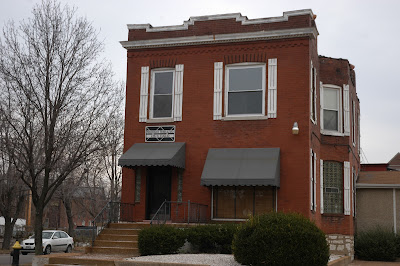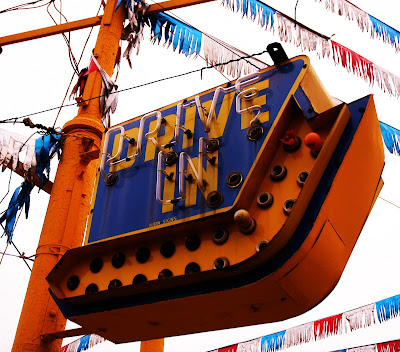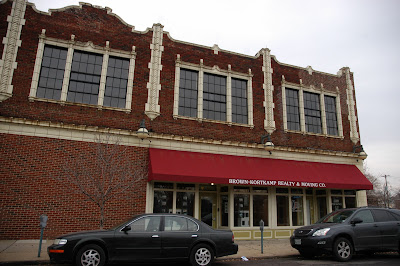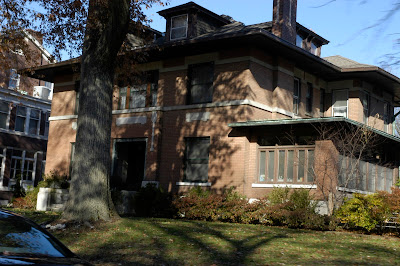I've read/heard tales of a St. Louis where kids would take emptied beer pales up to the corner tavern to refill it (probably sipping the top as not to spill on the way home) and bring it back home to mom and dad. I recall being served at 8 or 9 years old at fish stands in Smithton and Millstadt, Illinois and carrying the metal bucket filled with cold lager back to the adult table. I thought I was the king. I felt trusted and pretty big time.
I feel like a kid again as there is a microbrewery less than 1.5 miles from my house where I can fill my growler for $10 with tasty seasonal selections of hand crafted beer. Lucky me, now if I could just send my kids to get it for me....
I love living in a big city with plenty of neighborhood micro-brews. I love supporting small business and helping unique businesses thrive in our neighborhoods. St. Louis still needs more business to compliment the amazing housing stock. This would really set us apart from other cities in the United States.
Thursday, December 30, 2010
Friday, December 24, 2010
The Fountain Park Neighborhood
Fountain Park is a north St. Louis neighborhood bound by Dr. Martin Luther King Drive to the north, Delmar Boulevard to the south, Kingshighway Boulevard to the west and Walton Avenue to the east:
The 2000 census data counted 1,804 residents (down 23% from 1990's count) of whom 99% were black. There were 1,010 housing units counted, 75% occupied (32%/68% owner/renter split). 2010 census data counted 1,484 people, another 18% loss, down to 17 white people, 1,445 black people, 7 Hispanic/Latino and 1 Asian.
From the Fountain Park website:
If you can't make it out, the painted message on this abandoned property reads "No Loitering, Drinking or Drugs".
I'll tell some stories later when I get done with all the neighborhood profiles and will write a post on my run ins with racism, drugs, homelessness and prostitution in some parts of town. Today I got stopped by a caring policeman who questioned me as to my business in Fountain Park; he seemed somewhat interested and asked me to be safe. I appreciated him looking out for me.
Anyhow this neighborhood has seen it's share of bad behavior and carelessness that can't be ignored. It's a damn shame as this neighborhood is literally right across the street (Delmar Blvd.) from what most consider the bastion of urbanity and style and class: the Central West End neighborhood.
The immediate area surrounding Fountain Park for which the neighborhood takes its name could be one of the show places of St. Louis. The mid-19th century layout is stunning and to this day, it's clearly the most stable section of the neighborhood; but, it's not without its issues. The homes beautifully hug this oval shaped park framing a serene setting complete with huge old growth trees on the perimeter.
A beautiful church anchors the southwest side of the park:
And the fountain for which the park takes it's name is an eye catching centerpiece for the park, as well as a monument to Dr. Martin Luther King Jr that was unveiled in 1978.
There is an awesome building built in 1897 that occupies the northeast side of the park. It's a phenomenal structure and should be on the top 10 list of MUST SAVE places in this town. Today it sits uncared for and in wait for someone with the guts to save it.
Notice some weird commentary that exists on the building today:
Many others have written about this particular building: B.E.L.T., UrbanReviewSTL, Built St. Louis.
The 1.5 acre park was donated in 1889 by the gentlemen (John Lay) that laid out the neighborhood in 1857, then called Aubert Place. More on the history of the park and the fountain (source):
And then there is the crumbling housing stock that is impossible to ignore and must be shown to give you a feel for what this neighborhood is like today:
The bones of a great neighborhood are still here though, here are a couple of my favorites:
And here are a couple examples of the more contiguous stretches of inhabited homes:
There are several handsome and significant structures in Fountain Park. Euclid School:
A classic St. Louis firehouse:
The Missouri Terrazzo flooring company has a well maintained building that really stands out as a well maintained beauty (note the cool shutters):
Here's some stuff that caught my attention today:
Sights along Kingshighway between Delmar and MLK:
Delmar still has some amazing buildings in Fountain Park.
The Vault (pictured above) was a former bank renovated to a nightclub at one point. Check out this description:
The area around Fountain Park is a must see, go check it out. Maybe the more people that take notice, attention will be drawn to a place that clearly needs to be saved for future generations to enjoy.
The 2000 census data counted 1,804 residents (down 23% from 1990's count) of whom 99% were black. There were 1,010 housing units counted, 75% occupied (32%/68% owner/renter split). 2010 census data counted 1,484 people, another 18% loss, down to 17 white people, 1,445 black people, 7 Hispanic/Latino and 1 Asian.
From the Fountain Park website:
The Neighborhood is renowned for large stately houses, accessible shopping, convenient transportation, schools and numerous black churches within a stable community. Neighbors have organized and formed block units and neighborhood associations designed to maintain and improve the culture of the area. Two of these organizations are: The Enright Neighbors, and the Fountain Park Block Unit."Stable community" are not words that could be used to describe current day Fountain Park by most objective people. I must admit this is my second attempt at photographing this neighborhood. To make a long story short, I was convincingly asked to get the #$%& out the first time. The drug trade is alive and well on some streets in Fountain Park and it's as obvious and out in the open as can be.
The homes are regularly maintained. A few of the homes have been secured by private developers for rehab. These homes are available to potential neighbors, interested in becoming a part of the history of a solid family orientated neighborhood. Neighbors regularly gather to improve the neighborhood and support each other. They participate in the Operation Brightside clean-up and the National Night Out.
If you can't make it out, the painted message on this abandoned property reads "No Loitering, Drinking or Drugs".
I'll tell some stories later when I get done with all the neighborhood profiles and will write a post on my run ins with racism, drugs, homelessness and prostitution in some parts of town. Today I got stopped by a caring policeman who questioned me as to my business in Fountain Park; he seemed somewhat interested and asked me to be safe. I appreciated him looking out for me.
Anyhow this neighborhood has seen it's share of bad behavior and carelessness that can't be ignored. It's a damn shame as this neighborhood is literally right across the street (Delmar Blvd.) from what most consider the bastion of urbanity and style and class: the Central West End neighborhood.
A beautiful church anchors the southwest side of the park:
And the fountain for which the park takes it's name is an eye catching centerpiece for the park, as well as a monument to Dr. Martin Luther King Jr that was unveiled in 1978.
There is an awesome building built in 1897 that occupies the northeast side of the park. It's a phenomenal structure and should be on the top 10 list of MUST SAVE places in this town. Today it sits uncared for and in wait for someone with the guts to save it.
Notice some weird commentary that exists on the building today:
Many others have written about this particular building: B.E.L.T., UrbanReviewSTL, Built St. Louis.
The 1.5 acre park was donated in 1889 by the gentlemen (John Lay) that laid out the neighborhood in 1857, then called Aubert Place. More on the history of the park and the fountain (source):
When the Aubert Place subdivision was laid out by John Lay in 1857, a central oval shaped area was reserved for a park space. In 1889, it was donated by Lay to the city and was named Fountain Park, because of the fountain that was placed there was as a gift from the Merchants Exchange. It had been in the Exchange's trading hall for some years as a gift from John A. Scudder. Previously, it had graced Scudder's home near Grand Avenue and Olive Street. As an outdoor fountain, it proved to be a failure. It was constructed of flimsy materials causing the figures to be blown down during any ordinary storm. Also, the diameter of the iron ground basin was too small in comparison to the height of the fountain, causing the spray to be carried outside of the basin by the wind. During 1904, both the old house and the large fountain received two coats of paint to improve the appearance of the area. The fountain was renovated in 1964.There are some overwhelming obstacles to the neighborhood regaining it's original charm. Here are a couple examples of modern suburban failures (note the ample parking for....nothing):
William Severson of Ladue was the sculptor for the renovation of the fountain and Karl Kraus was the contractor. The cost of this renovation was $4,660. The work was done as part of $15,400 renovation of the park. The work was paid for out of the 1955 Bond Issue funds.
The process employed included creation of molds of details that were missing by using those details that remained. Details were cast from the molds using epoxy reinforced by fiberglass cloth. The main body of the fountain was sand blasted and repainted with zinc epoxy to protect and preserve it. New plumbing was installed and the interior of the fountain was filled with concrete to add strength. Epoxy glass cloth reinforcement was applied to the existing bowls.
The original fountain material was cast iron that had become badly pitted by the time of the renovation. It was estimated that the fountain had been in service over 50 years when finally renovated. It was the opinion of the sculptor that the renovation work had left the fountain in better condition then when it was cast.
And then there is the crumbling housing stock that is impossible to ignore and must be shown to give you a feel for what this neighborhood is like today:
The bones of a great neighborhood are still here though, here are a couple of my favorites:
And here are a couple examples of the more contiguous stretches of inhabited homes:
There are several handsome and significant structures in Fountain Park. Euclid School:
A classic St. Louis firehouse:
The Missouri Terrazzo flooring company has a well maintained building that really stands out as a well maintained beauty (note the cool shutters):
Here's some stuff that caught my attention today:
Sights along Kingshighway between Delmar and MLK:
Delmar still has some amazing buildings in Fountain Park.
The Vault (pictured above) was a former bank renovated to a nightclub at one point. Check out this description:
After a $3 million renovation, The Vault (a former bank, hence the name) has earned a reputation among the premier night clubs in St. Louis. The dance floor is the largest in the city and the upscale motif attracts club heads, celebutants, and folks just looking to have a good time. Those with two left feet can still impress a date by displaying stellar skills on the pool table in the game room adjacent to the dance floor. And if all else fails, the highly skilled bartenders will prepare a cocktail to make anyone look more attractive among the luxurious gold mirrors and lavish couches. Make sure to check out the VIP room, which once was an actual bank vault.Mmmm celebutants and gold mirrors, a tasty combination indeed...
The area around Fountain Park is a must see, go check it out. Maybe the more people that take notice, attention will be drawn to a place that clearly needs to be saved for future generations to enjoy.
Tuesday, December 21, 2010
Daydream # 383
The housing market has seen a downturn no doubt. But people still need a roof over their heads. We still have and need a diverse set of housing stock to meet the ups and downs of a housing market that can appeal to both prospective owners and renters and lessees. Rentals, townhouses, single family homes...all coexisting to create a whole neighborhood.
There are many, many re-habbers making great progress in this city. I've seen them as far north as Riverview and as far south as the Patch. People that care and want to see properties brought back to life while making a living seems like the perfect match. Grassroots efforts are WAY more impactful for the long term health of our neighborhoods and our city as a whole than the huge entertainment projects like Ballpark "Village" (no residential?), Bottle District, etc. that get so much attention around town.
I drive down many dilapidated streets and see a property being rehabbed and I laud the efforts of these folks, but I can't help but feel like their efforts are overwhelmed by the staggering amount of negativity and neglect that surrounds their noble efforts in some parts of the city. On the other hand, I've seen some homes being renovated on streets in Tower Grove South, Shaw, Lafayette Square or Soulard that are the last shell or rehab available on the block...the icing on the cake so to speak. Both are important, and there's so much left to be done.
So why not call all re-habbing hands on deck to work together in a concerted fashion to work toward transforming and marketing streets, blocks, neighborhoods to new residents. The sweeping power of an effort of this scale would be overwhelming. Money would more easily be made if folks worked together to reclaim an entire street. Resources could be pooled.
An entire neighborhood, take Fox Park for example, which is working toward extending its historic status south of Shenandoah to cover the entire neighborhood could be a perfect case study for this type of effort. Start on Ann Street and work south to the end of the neighborhood. Market the neighborhood to renters, owners and lessees. Work toward drawing small business, the local and national press and everyone else to take notice of the concerted efforts to take a single neighborhood on the fringe and elevate it to a regional showplace.
I have always said that bringing a vacant property back to life is the single greatest thing one can do for the betterment of St. Louis. Taking a 4 family down to a 2 family townhouse or a 2 family to a single family dwelling is what we need. We have a city built for 1 million when we only have ~350,000 residents. We should prepare for a solid 500,000.
Hey I can dream can't I?
Yours truly is getting ready to toss our hat in the ring....more on those adventures in 2011.
There are many, many re-habbers making great progress in this city. I've seen them as far north as Riverview and as far south as the Patch. People that care and want to see properties brought back to life while making a living seems like the perfect match. Grassroots efforts are WAY more impactful for the long term health of our neighborhoods and our city as a whole than the huge entertainment projects like Ballpark "Village" (no residential?), Bottle District, etc. that get so much attention around town.
I drive down many dilapidated streets and see a property being rehabbed and I laud the efforts of these folks, but I can't help but feel like their efforts are overwhelmed by the staggering amount of negativity and neglect that surrounds their noble efforts in some parts of the city. On the other hand, I've seen some homes being renovated on streets in Tower Grove South, Shaw, Lafayette Square or Soulard that are the last shell or rehab available on the block...the icing on the cake so to speak. Both are important, and there's so much left to be done.
So why not call all re-habbing hands on deck to work together in a concerted fashion to work toward transforming and marketing streets, blocks, neighborhoods to new residents. The sweeping power of an effort of this scale would be overwhelming. Money would more easily be made if folks worked together to reclaim an entire street. Resources could be pooled.
An entire neighborhood, take Fox Park for example, which is working toward extending its historic status south of Shenandoah to cover the entire neighborhood could be a perfect case study for this type of effort. Start on Ann Street and work south to the end of the neighborhood. Market the neighborhood to renters, owners and lessees. Work toward drawing small business, the local and national press and everyone else to take notice of the concerted efforts to take a single neighborhood on the fringe and elevate it to a regional showplace.
I have always said that bringing a vacant property back to life is the single greatest thing one can do for the betterment of St. Louis. Taking a 4 family down to a 2 family townhouse or a 2 family to a single family dwelling is what we need. We have a city built for 1 million when we only have ~350,000 residents. We should prepare for a solid 500,000.
Hey I can dream can't I?
Yours truly is getting ready to toss our hat in the ring....more on those adventures in 2011.
Saturday, December 4, 2010
The Skinker/Debaliviere Neighborhood
Skinker/Debaliviere lost 3% of its residents from 1990-2000 when 4,505 people were counted. 50% black, 42% white, 5% Asian and 2% Hispanic/Latino. 2,348 total housing units were in existence as of 2000, with a dynamite 90% occupancy rate, 41% of which is owner occupied, 59% rental. Unfortunately the 2010 census data revealed another 10% loss with racial shift occurring: 50% white, 38% black, 9% Asian and 3% Hispanic/Latino.
This is one of the greatest neighborhoods in St. Louis. Why? Well, it abuts Forest Park one of America's greatest urban parks. Then you have the mansions along Lindell Boulevard. The Metrolink blue line stops here with an underground stop at Forest Park Parkway and Skinker. The East Loop is on your doorstep as is the Washington University Danforth Campus. It's really a beautiful, very urban, walkable neighborhood. There's a lot to like here. And with the news of a potential grocery/farmer's market right by the Delmar Metrolink stop on the red line (technically in the West End neighborhood), the sky is the limit for Skinky-D. This is one of the St. Louis neighborhoods that make you feel like you're in a big city. There are scooters, bikers, walkers everywhere. It's a vibrant place. There is a small branch of the St. Louis Public Library right along Skinker (note the bike rack).
I'm not alone in lauding the pluses of what some call "the Skinky-D", Here's a note from the neighborhood website:
If there are downsides to Skinker Debaliviere it's the excruciatingly frustrating one way and intentionally blocked off streets. It's nearly impossible to navigate your way around this neighborhood in a car. But the pluses far outweigh the negatives (street closing can be reversed right?).Skinker DeBaliviere has a history that is as deeply rooted in the St. Louis legend as the 1904 World's Fair, an event that spurred the rapid development of the institutions and homes in the area. Today, the neighborhood continues to be one of the most vital and livable neighborhoods in the metropolitan area, due in part to the dedication of it's residents and institutions.
A major attraction for homeowners is the great diversity of housing in Skinker DeBaliviere. Ranging from historic single-family homes on quiet private and public streets, to newly constructed town homes in Kingsbury Square, to gracious two-family flats and apartment buildings, the neighborhood offers a wide selection of housing options. Nearly all homes include spacious rooms, and most are ornamented with the exquisitely detailed millwork, art glass and fireplace mantles of the early 20th century style. This traditional architectural beauty, along with a gracious yet thoroughly modern lifestyle, has not only kept many families happily anchored in the neighborhood for generations, but has resulted in the return of several second and third generation Skinker DeBaliviere families who had previously moved away.
The neighborhood was designated a Local Historic District by the City of St. Louis in 1978, and the private subdivision of Parkview is listed in the National Register of Historic Places.
Let's start with the mansions along Lindell. There are classics:
To the more contemporary:
Most of the street in Skinker-Debaliviere have mature trees and nice shaded streets with lots of pedestrian activity on the sidewalks. Here are some of the typical homes you'll see in throughout the neighborhood:
There is a rather unique late 1980's era development called Kingsbury Square off of Debaliviere that looks like a suburban enclave right in the middle of the city. The development in centered around a nice park:
It's like a little Mayberry U.S.A. scene that seems to contradict the rest of the neighborhood, but somehow sets itself apart as a nice option for city living with a small town feel.
So the housing stock is top notch, what about rental property? Some of the nicest in apartment buildings in the city:
Obviously there are some great properties in this neighborhood. There's also a lot to do within walking distance. You can walk to the Metrolink stop at Forest Park Pkwy/Skinker after a nice cup of joe:
Stop into the library:
Take a leisurely stroll through the neighborhood on a pedestrian cut-thru:
Great restaurants and retail on Delmar:

The fun, urban streetscape of Delmar is dealt a distasteful blow right at DeBaliviere Ave where Metro built what amounts to a city block length brick wall. There is a classy older building right at the corner, but the poor design of the maintenance building shuts off the potential for any interest from the sidewalk/street.
The Pulaski Bank on DeBaliviere is one of my favorite banks in the city; and it's a proud reminder of the thought and care that went into designing this neighborhood:
Unfortunately, there are some butt ugly contemporary strip malls that have done their best to cheapen the look of the neighborhood along DeBaliviere:
Skinker Debaliviere is another example of St. Louis' unique and vibrant neighborhoods.
Subscribe to:
Comments (Atom)




































































































































